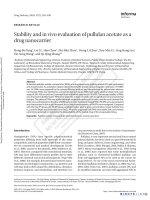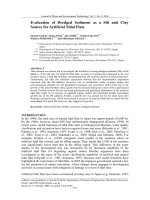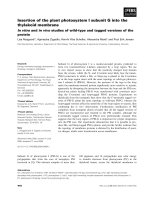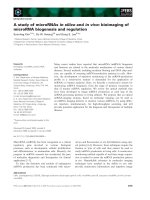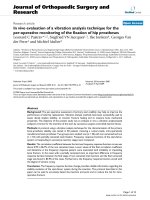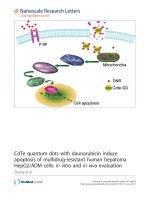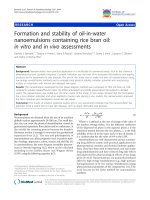Stability and in vivo evaluation of pullulan acetate as a drug nanocarrier
Bạn đang xem bản rút gọn của tài liệu. Xem và tải ngay bản đầy đủ của tài liệu tại đây (1.13 MB, 7 trang )
Introduction
Nanoparticles (NPs) have specic physicochemical
properties diering from bulk materials of the same
composition, and such properties make them very attrac-
tive for commercial and medical development (Curtis
et al., 2006; Lanone & Boczkowski, 2006; Medina et al.,
2007). However, compared with conventional materials,
NPs may have dierential toxicity proles due to their
dierent chemical and structural properties (Vega-Villa
et al., 2008). For example, the interaction between nano-
materials and biological components, e.g. proteins and
cells may lead to their unique bio-distribution, clearance,
immune response, and metabolism, and therefore it is
very necessary to study the in vivo toxicity of nanomateri-
als (Fischer & Chan, 2007).
Pullulan, a very important neutral and linear natural
polysaccharide, has been used as a good biomaterial in
drug and gene delivery, tissue engineering, and other
elds (Leathers, 2003; Shingel, 2004; Rekha & Sharma,
2007). Many investigations (Akiyoshi et al., 1993; Jeong
et al., 2006) have reported that some hydrophobized
pullulan such as cholesterol-modied pullulan can
form self-aggregated NPs to be used as the carrier for
drug delivery. As one of the most conventional hydro-
phobized pullulan derivatives (Jung et al., 2003; Na et al.,
2003; 2004, Park et al., 2007), pullulan acetate (PA) and
its modied materials can form self-aggregated NPs in
Drug Delivery, 2010; 17(7): 552–558
Address for Correspondence: Qi-Qing Zhang, Institute of Biomedical Engineering, Chinese Academy of Medical Sciences, Peking Union Medical College,
e Key Laboratory of Biomedical Material of Tianjin, Tianjin 300192, PR China. Tel/Fax: +86 22 87890868. E-mail:
RESEARCH ARTICLE
Stability and in vivo evaluation of pullulan acetate as a
drug nanocarrier
Hong-Bo Tang
1
, Lei Li
1
, Han Chen
1
, Zhi-Min Zhou
1
, Hong-Li Chen
1
, Xue-Min Li
1
, Ling-Rong Liu
1
,
Yin-Song Wang
3
, and Qi-Qing Zhang
1,2
1
Institute of Biomedical Engineering, Chinese Academy of Medical Sciences, Peking Union Medical College, e Key
Laboratory of Biomedical Material of Tianjin, Tianjin 300192, PR China,
2
Research Center of Biomedical Engineering,
Department of Biomaterials, College of Materials, Xiamen University, Technology Research Center of Biomedical
Engineering of Xiamen City, e Key Laboratory of Biomedical Engineering of Fujian Province, Xiamen 361005, PR
China, and
3
College of Pharmacy, TianJin Medical University, Tianjin, 300070, PR China
Abstract
To develop pullulan acetate nanoparticles (PANs) as a drug nanocarrier, pullulan acetate (PA) was synthesized
and characterized. Its acetylation degree determined by the proton nuclear magnetic resonance (
1
H NMR)
was 2.6. PANs were prepared by the solvent diffusion method and characterized by transmission electron
microscope (TEM), size distribution, and ζ potential techniques. PANs had nearly spherical shape with a size
range of 200–450 nm and low ζ potentials both in distilled water and in 10% FBS. The storage stability of PANs
was observed in distilled water. PANs were stored for at least 2 months with no significant size and ζ potential
changes. The safety of PANs was studied through single dose toxicity test in mice, and the result showed that
PANs were well tolerated at the dose of 200 mg/kg in mice. Epirubicin-loaded PANs (PA/EPI) were also prepared
and characterized in this study. Moreover, the in vivo pharmacokinetics of PA/EPI was investigated. Compared
with the free EPI group, the PA/EPI group exhibited higher plasma drug concentration, longer half-life time
(t
1/2
) and the larger area under the curve (AUC). All results suggested that PANs were stable, safe, and showed
a promising potential on improving the bioavailability of the loaded drug of the encapsulated drug.
Keywords: Pullulan acetate; nanoparticles; pharmacokinetics; toxicity; epirubicin
(Received 26 December 2009; revised 20 April 2010; accepted 28 April 2010)
ISSN 1071-7544 print/ISSN 1521-0464 online © 2010 Informa Healthcare USA, Inc.
DOI: 10.3109/10717544.2010.490250
/>Drug Delivery
2010
17
7
552
558
26 December 2009
20 April 2010
28 April 2010
1071-7544
1521-0464
© 2010 Informa Healthcare USA, Inc.
10.3109/10717544.2010.490250
DRD
490250
Drug Delivery Downloaded from informahealthcare.com by University of Technology Sydney on 03/01/11
For personal use only.
Stability and in vivo evaluation of pullulan acetate 553
aqueous media. e hydrophobic core of these self-
assembled NPs formed by the hydrophobic interactions
was considered to act as a reservoir of hydrophobic
substances. In our previous report (Zhang et al., 2009),
PANs prepared by the solvent diusion method had the
potential to be used as a sustained release carrier for
Epirubicin (EPI) in vitro. Some investigations (Gu et al.,
1998; Na et al., 2004; Shimizu et al., 2008) showed that
NPs of hydrophobized pullulans had good morphol-
ogy, drug loading, and release properties in vitro, but
the biological eects of hydrophobized pullulan NPs
in vivo have not been investigated deeply up to date.
Herein, based on our previous work, we studied the
stability and toxicity of PANs, and further investigated
the sustained release behavior in vivo of drug loading in
PANs. PA was rstly synthesized and characterized by
FT-IR and
1
H NMR, and then PANs with moderate size
and low potential were prepared by the solvent diusion
method. e storage stability of PANs was studied in the
aqueous medium, and the acute toxicity of PANs was
evaluated in mice. Morever, EPI was loaded into PANs
and its pharmacokinetics was also assessed in rats to
compare to the free drug.
Methods
Materials
Pullulan (Mw = 200,000) was purchased from Hayashibara
(Tokyo, Japan). Epirubicin·HCl (EPI·HCl) was purchased
from Hisun Pharmaceutical Co. (Zhejiang, China). Poly
(vinyl alcohol) (PVA) with an average molecular weight
of 30,000–70,000 was obtained from Sigma-Aldrich (St.
Louis, MO). All reagents for high performance liquid
chromatography (HPLC) analysis, including acetonitrile
and methanol, were HPLC grade. Other chemical reagents
were of analytical grade and obtained from commercial
sources. ICR mice and Wistar rats were purchased from
the Institute of Radiology, Chinese Academy of Medical
Science. All animal experiments were performed in
compliance with the Institutional Animal Care and Use
Committee (IACUC) guidelines.
Synthesis and characterization of PA
PA was synthesized according to the method described
in previous literature (Jung et al., 2003; Zhang et al.,
2009). Briey, pullulan (2 g) was suspended in 20 ml of
formamide and dissolved by vigorous stirring at 54°C.
Pyridine (6 ml) and acetic anhydride (5.5 ml) were added
to the above solution, and the mixture was subsequently
stirred at 54°C for 48 h. e reactant was precipitated with
distilled water, and then washed with distilled water and
methanol. e solid material was vacuum-dried at 50°C
for 48 h. e nal product was identied by Fourier trans-
form infrared (FT-IR) (ermo, Nicolet is10, Los Angeles,
CA ) and
1
H NMR (Varian, Varian INOVA. 400 M NMR,
Palo Alto, CA) spectrometry. e degree of substitution
(DS) was dened as the number of acetyl groups per
glucose unit of pullulan. It was determined by
1
H NMR
(Zhang et al., 2009). e DS values are expressed by the
following equations: DS = 10A/(3B + A), where A is the
integration value of acetyl protons at 1.8–2.2 ppm and B
is that of OH protons and H-1 to H-6 protons of pullulan
moiety observed at more than 3.5 ppm.
Preparation and characterization of PANs and PA/EPI
Nanoparticles were prepared according to a solvent dif-
fusion method (Fessi et al., 1989; Govender et al., 1999;
Bilati et al., 2005; Zhang et al., 2009). Briey, PA (100 mg)
was dissolved in 10 ml of N, N-Dimethylformamide
(DMF). e solution was then added to 0.5% PVA
aqueous solution through a syringe under moderate
magnetic stirring. e produced PANs were collected
with centrifugation (Beckman Coulter, Inc. Avanti
J-25, Fullerton, CA) at 18,000 rpm for 15 min at 4°C.
Subsequently, PANs were dispersed in the distilled
water and 10% fetal bovine serum (FBS), respectively,
with PA concentration of 1 mg/ml to carry out the later
experiments.
EPI-loaded PANs were prepared as follows: EPI·HCl
(10 mg) was dissolved in DMF (2 ml) and then triethyl-
amine (TEA) was added to this solution to remove
hydrochloride. e mixed solution was stirred in the
dark for 12 h. PA (100 mg) dissolved in 8 ml of DMF
was added into this mixed solution. e PA/EPI were
collected with centrifugation (Beckman Coulter, Inc.
Avanti J-25, Fullerton, CA) at 18,000 rpm for 15 min at
4°C, then the supernatant removed and washed twice
with distilled water, at last, dispersed in distilled water
by sonication for several minutes with a probe-type
sonier (Automatic Ultrasonic Processor UH-500A,
China) at 100 W.
e particle size and ζ potential were determined
by dynamic light scattering (Malvern Instruments Ltd.,
Zeta sizer 2000, Worcestershire, UK). e morphology
of NPs was observed using TEM (FEI, TECNAI G2F-20,
Eindhoven, Holland).
e stability of PANs in water
In order to study the stability of PANs, the above disper-
sions were stored for 2 months at 4°C. Macroscopic char-
acteristics of NPs dispersions such as opalescence and
precipitation were observed from time to time. Moreover,
the size and ζ potential of PANs were also determined by
dynamic light scattering method once a month, and all
measurements were performed in triplicate.
Drug Delivery Downloaded from informahealthcare.com by University of Technology Sydney on 03/01/11
For personal use only.
554 H.-B. Tang et al.
In vivo toxicity
e toxicity of PANs was evaluated in vivo according to
the previous reported method (Yoksan & Chirachanchai,
2008; Sonaje et al., 2009). Adult male and female ICR mice
(18–22 g) were randomly divided into two groups, each
with 10 mice. e experimental group received a single
intravenous (i.v.) dose of blank PANs (200 mg/kg); the
other group was treated with a single i.v. dose of normal
saline. All animals were fed with normal diet, and water
was provided ad libitum. Animals were observed care-
fully for the onset of any signs of toxicity and monitored
for changes in food intake and body weight at 1, 8, and
15 days. After being sacriced at 15 days, internal organs
of each animal were harvested and observed grossly. For
histological examinations, specimens of major organs
such as heart, liver, spleen, lung, and kidney were xed
in 10% phosphate buered formalin, embedded in paraf-
n, sectioned, and stained with hematoxylin and eosin
(H&E).
In vivo pharmacokinetics and bioavailability
In vivo pharmacokinetic study was conducted by the
routine method (Mross et al., 1988; Bibby et al., 2005;
Cao & Feng, 2008; Devalapally et al., 2008). e drug
content of the PA/EPI was determined according to
our previous study (Zhang et al., 2009) and PA/EPI with
3.34% was selected to carry out the pharmacokinetics
studies. Female Wistar rats of 180~250 g and 4~6 weeks
old were held in an air-conditioned facility, provided
with standard food and ltered water. Animals were ran-
domly assigned to two groups, each with six rats, which
received an i.v. injection via the tail vein of free EPI and
the PA/EPI solution in saline at 10 mg/kg equivalent
dose, respectively. All animals were observed for mortal-
ity, general condition, and potential clinical signs.
e blood samples were collected with heparinized
tube at 0 (pre-dose), 0.0167, 0.0833, 0.167, 0.5, 1, 2, 4, 8,
12, 24, and 48 h post-treatment. Plasma samples were
harvested by centrifugation at 3000 rpm for 15 min and
stored at −20°C until analysis. Liquid–liquid extraction
was performed prior to the HPLC analysis. Briey, the
plasma (100 µl) was mixed with dichloromethane-meth-
anol (4:1, v/v) on a vortex-mixer for 3 min to extract the
drug. Upon centrifugation at 10,000 rpm (15,000 g) for
15 min, the upper aqueous layer was removed by aspi-
ration and the organic layer was transferred to a tube
and evaporated under nitrogen at 50°C. e residue was
dissolved in 100 µl of anhydrous methanol by vortex. For
the HPLC analysis, the C-18 column was used and the
mobile phase (0.02 M KH
2
PO
4
/CH
3
CN/CH
3
OH = 49:17:34
v/v/v) was delivered at a rate of 1 ml/min. Sample (20 μl)
was injected and the column euent was detected with
a UV detector at 232 nm. e main pharmacokinetic
parameters were calculated by DAS 1.0 (Anhui, China)
program.
Bioavailability (BA) is a measurement of the rate and
extent of a therapeutically active drug that reaches the
systemic circulation and is available at the site of action.
When a medication is administered intravenously, its
bioavailability is 100%. When the standard consists of
intravenously administered drug, this is known as relative
bioavailability (BA
R
). e BA
R
of PA/EPI after administra-
tion was calculated using the following formula (Sonaje
et al., 2009):
BA
(AUC )Dose
(AUC )Dose
100
R
AB
BA
=
×
×
×%
()
()
where AUC is the area under the curve.
Statistical analysis
All data are presented as a mean value with its stand-
ard deviation indicated (mean ± SD). Statistical analysis
was conducted using the Student’s t-test. Dierences
were considered to be statistically signicant when the
p-values were less than 0.05.
Results and discussion
Characterization of PA
Pullulan has three free hydroxyl groups on each glucose
unit. It is easy to synthesize hydrophobic pullulan deriva-
tive, PA, by means of replacing the hydroxyl groups of the
glucose unit with acetate groups. Figure 1 shows FT-IR
spectra of pullulan and PA, which were similar to our
previous literature (Zhang et al., 2009). Figure 2 shows
1
H NMR spectra of pullulan and PA in DMSO-d
6
. e
acetylation degree of PA calculated by
1
H NMR method
was 2.6, which is smaller than 2.7 reported by Zhang et al.
(2009). Based on our previous report, PA with lower DS
may form smaller NPs in size. Moreover, Li and Huang
3500 3000 2500 2000 1500 1000 500
Wavenumber (cm
−1
)
a
b
Figure 1. FT-IR spectra of PA (a) and pullulan (b).
Drug Delivery Downloaded from informahealthcare.com by University of Technology Sydney on 03/01/11
For personal use only.
Stability and in vivo evaluation of pullulan acetate 555
(2008) also reported that the smaller size of NPs may be
in favor of longer circulation time in vivo. erefore, PA
with acetylation degree of 2.6 was used to prepare PANs
and PA/EPI in our study.
Characterization of PANs and PA/EPI
e self-assembled NPs were prepared by solvent dif-
fusion method. is method had several advantages
such as a rapid and simple preparation procedure, great
potential for large industrial scale production, and easy
control of the particle size (Zhang et al., 2009). e size
and the size distributions of PANs and PA/EPI in distilled
water were measured by DLS. e morphological char-
acteristics were observed by TEM at the same time. As
shown in Table 1, the mean diameters of PANs and PA/
EPI were 247.6 ± 34.8 nm and 343.4 ± 87.7 nm, with the
narrow size distributions (the polydispersity indexes
(PDI) < 0.3, Figure 3). Under TEM observations (Figure 4),
PANs and PA/EPI were nearly spherical in shape and uni-
form sized.
ζ potential of NPs in dierent media
e ζ potentials of PANs and PA/EPI in distilled water
were −3.353 ± 1.296 mV and −3.297 ± 1.025 mV. To model
the circulation in vivo, we observed the ζ potentials of
NPs in 10% FBS, which had a composition very similar
to the body liquids. e ζ potentials of PANs and PA/EPI
in 10% FBS were −1.460 ± 0.297 and −1.902 ± 1.112 mV.
According to the previous report (Levchenko et al., 2002;
Alexis et al., 2008), neutral NPs would exhibit a decreased
rate of macrophage phagocytosis system (MPS) uptake.
However, MPS is the major contributor for the clearance
of NPs, thus the reducing rate of MPS uptake could be
considered as the best strategy for prolonging the cir-
culation of NPs (Li & Huang, 2008). erefore, PA/EPI
prepared in this study would exhibit the longer blood
circulation time than free EPI in vivo.
e storage stability of PANs
Stability is an important facet of preparation and a neces-
sary step in the development process, it will indicate the
potentiality of industry production. e possibilities of
modulating the loaded drug’s pharmacokinetic param-
eters are dependent on physicochemical properties such
as stability, size, and surface characteristics (Lourenco
et al., 1996). PANs dispersions maintained slight opal-
escence within 2 months. As shown in Table 2, the size,
size distribution, and ζ potential of PANs showed no sig-
nicant changes during 2 months. erefore, it could be
concluded that PANs in aqueous media were stable for
at least 2 month at 4°C. Stabilization of colloidal systems
is traditionally viewed as arising from either electrostatic
or steric eects (Lourenco et al., 1996). A ζ potential of at
least −30 mV for electrostatic stabilized systems is desired
to obtain a physically stable suspension according to the
literature (Müller & Jacobs., 2002). e higher zeta poten-
tial value indicates the better stability (Dai et al., 2010).
e absolute value of ζ potential was lower than 5 mV
in our study. e result showed that electrostatic stabi-
lization was not provided eciently in the suspension;
5.0
a
b
ppm (t1)
4.0 3.0 2.0
Figure 2.
1
H NMR spectra of pullulan (a) and PA (b) (DMSO-d6).
1000100
Size (d.nm)
Size Distribution by intensity
Intensity (%)
101
20
a
15
10
5
0
10000
Undersize
100
80
60
40
20
0
1000100
Size (d.nm)
Size Distribution by intensity
Intensity (%)
101
20
b
15
10
5
0
10000
Undersize
100
80
60
40
20
0
Figure 3. Diameter distributions of PANs (a) and PA/EPI (b).
Table 1. Size and PDI of PANs and PA/EPI ( ± s, n = 6).
NPs Diameter (nm) PDI
PANs 247.6 ± 34.8 0.179 ± 0.057
PA/EPI 343.4 ± 87.7 0.195 ± 0.069
Drug Delivery Downloaded from informahealthcare.com by University of Technology Sydney on 03/01/11
For personal use only.
556 H.-B. Tang et al.
therefore, a steric stabilization may occur and provide the
stability of the PANs. It may also be important information
for developing a new nanosuspension liquid formulation
about pullulan acetate.
In vivo toxicity
To evaluate whether i.v. administration (at dose of
200 mg/kg) of PANs was associated with any toxicity in
vivo, animals were treated with a single dose of empty
NPs. No signicant dierences between the PANs group
and the control group in clinical signs, e.g. diarrhea, fever,
and other systemic symptoms, and no mortality occurred
throughout the entire study course. Additionally, there
were no signicant dierences in body weight and food
intake for both male and female mice between the two
studied groups (Tables 3 and 4). Figure 5 shows the
microscopic examination of major organs including
heart, liver, spleen, lung, and kidney sections stained with
H&E. Pathological changes in the major organs including
heart, liver, spleen, lung, kidney, stomach, and intestinal
segments were scarcely observed at 15 days. Moreover,
no evidence of inammatory reactions was observed in
the experimental group. All the above results indicated
that no apparent toxicity of the PANs was found in the
experimental animals after i.v. at a dose of 200 mg/kg.
In vivo pharmacokinetics
e plasma levels of EPI were determined following a sin-
gle i.v. injection of EPI or PA/EPI (10 mg/kg EPI equiv.) in
female Wistar rats. e plasma levels over 48 h are shown
in Figure 6 and the PK parameters are summarized in
Table 5. e peak concentration of total EPI in plasma was
14.65 mg/L at 1 min after injection and then decreased to
nearly undetectable levels after 24 h. e maximum con-
centration (C
max
) of PA/EPI at 5 min was 9.80 mg/L, which
was obviously lower than that of EPI because of sustained
release from NPs. According to the previous report (Mross
et al., 1988; Jakobsen et al., 1991; 1994), free EPI rapidly
Table 2. Diameter and ζ potential of PANs ( ± s, n = 3).
Time Diameter (nm) PDI ζ potential (mV)
Day 0 260.4 ± 8.03 0.180 ± 0.025 −3.353 ± 1.296
1 month 242.4 ± 27.15 0.162 ± 0.073 −2.058 ± 1.987
2 month 229.5 ± 17.78 0.136 ± 0.085 −1.580 ± 2.153
Table 3. Body weight of PANs i.v. injected in mice at 200 mg/kg dose
( ± s, g).
Group Sex n Day 1 Day 8 Day 15
Control
5 18.46 ± 0.81 23.12 ± 1.51 24.90 ± 1.04
5 18.64 ± 1.17 25.68 ± 2.81 30.02 ± 2.25
PANs
5 18.14 ± 0.68 22.85 ± 1.12 24.96 ± 0.88
5 18.68 ± 0.51 26.30 ± 0.80 30.06 ± 1.48
Table 4. Food intake of PANs i.v. injected in mice at 200 mg/kg dose
( , g).
Group Sex n Day 8 Day 15
Control
5 4.97 5.12
5 5.62 6.50
PANs
5 4.57 5.26
5 5.53 6.40
ab
Liver
Spleen
Kidney
Lung
Heart
Figure 5. Representative photomicrographs of the heart, liver, spleen,
lung, and kidney sections (H&E staining) of mice of control group (a)
and treated with test NPs (b).
a
100 nm
0.2 µm
b
Figure 4. Transmission electron micrographs (TEM) of (a) PANs and
(b) PA/EPI.
Drug Delivery Downloaded from informahealthcare.com by University of Technology Sydney on 03/01/11
For personal use only.
